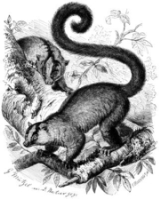
Masoala Fork-crowned Lemur
Encyclopedia
The Masoala fork-marked lemur (Phaner furcifer), also known as the eastern fork-marked lemur or Masoala fork-crowned lemur, is found in the coastal forests of northern and western Madagascar
.
Phaner furcifer subsists on a diet consisting mainly of the gum of trees in temperate deciduous
forests. It has become specialized for harvesting this substance. Like most prosimian
s, it has a "dental comb," which is used to scrape the gum that oozes from insect holes in a tree's surface. This structure consists of a row of lower teeth that are long and forward pointing.
The female experiences estrous for only 3 to 4 days of the entire year, typically in June. She gives birth to a single offspring in November or December. The offspring initially lives in the tree hole of the parents, then is carried by the mother, first ventrally, then dorsally.
Madagascar
The Republic of Madagascar is an island country located in the Indian Ocean off the southeastern coast of Africa...
.
Phaner furcifer subsists on a diet consisting mainly of the gum of trees in temperate deciduous
Deciduous
Deciduous means "falling off at maturity" or "tending to fall off", and is typically used in reference to trees or shrubs that lose their leaves seasonally, and to the shedding of other plant structures such as petals after flowering or fruit when ripe...
forests. It has become specialized for harvesting this substance. Like most prosimian
Prosimian
Prosimians are a grouping of mammals defined as being primates, but not monkeys or apes. They include, among others, lemurs, bushbabies, and tarsiers. They are considered to have characteristics that are more primitive than those of monkeys and apes. Prosimians are the only primates native to...
s, it has a "dental comb," which is used to scrape the gum that oozes from insect holes in a tree's surface. This structure consists of a row of lower teeth that are long and forward pointing.
The female experiences estrous for only 3 to 4 days of the entire year, typically in June. She gives birth to a single offspring in November or December. The offspring initially lives in the tree hole of the parents, then is carried by the mother, first ventrally, then dorsally.

